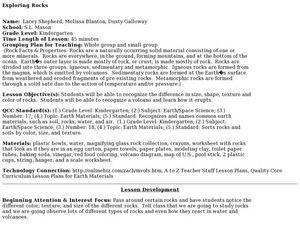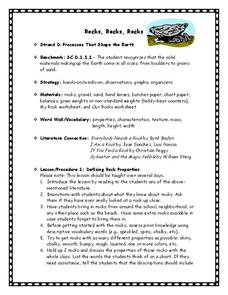Alabama Learning Exchange
Coral Reefs
Study explore coral reefs. In this coral reef lesson, 4th graders examine the physical structure of coral reefs. Students consider why coral reefs need to be protected and ways to protect them.
Curated OER
Go Glacier Go!
Students create a model of a glacier and observe how it moves. In this landforms lesson plan, students learn what a glacier is, build a model glacier and observe how it moves in a manner that more closely resembles a liquid than a solid.
Curated OER
Earthquake Epicenters and Magnitudes
Students work on a virtual earthquake to increase their understanding of seismograms, earthquake epicenters, Richter Magnitude and triangulation when finding the epicenter of an earthquake.
Curated OER
Plate Tectonic - Volcanoes Pre Lab
Second graders draw and compare parts of volcano. They investigate parts of a volcano and distinguish between magma and lava.
Curated OER
Exploring Rocks
Students collect and examine rocks. They record information about the rocks they have collected in their notebooks. They compare and contrast different rocks and complete a class chart at the end of the lesson.
Alabama Learning Exchange
Tornadoes
Students research tornadoes. For this weather instructional activity, students construct a KWL chart on tornadoes and view the video National Geographic-Tornadoes. Students discuss the facts they learned from the film and complete the...
Curated OER
Air and Water in the Environment
Second graders participate in a three part activity in which they identify and describe forms of moisture in the environment. Part one of the activity involves the three stages of the water cycle, part two focuses on creating humidity...
Curated OER
What Does Plant Biology Teach Is About Climate?
Students examine what factors influence climate. In this investigative lesson students compare the factors that influence climate and how they effect tree growth.
Curated OER
Earthquake Waves And Their Destructions
Students investigate primary and secondary waves and how to measure the magnitude of waves. They discover how to find the epicenter of earthquakes. They examine why waves are more destructive in some areas than others through these...
Curated OER
Moon Phases
Students engage in a study looking for the differences found during the cycle of one lunar month. They conduct research using a variety of resources. Then the information is used to construct a lunar calendar to observe daily changes and...
Curated OER
Weather Predictions
Students record weather data and create a five day forecast. Students investigate the roles of meteorologists and identify symbols used on a weather map. After gathering weather data for a week, students will create a five day forecast...
Curated OER
Its Getting Thinner and Thinner
Students design posters on the ozone to be judged. They design a board game on the depletion of the ozone and list the layers of the atmosphere. They construct a collage of the atmosphere into layers according to the way temperature...
Curated OER
Metals, Nonmetals, Metalloids
Young scholars recognize that metals, nonmetals, and metalloids have common attributes. They Identify physical and chemical properties. Students define ores and identify where ores can be found.
Curated OER
The Scientist in Me
Students make a poster. In this scientist lesson, students define the term scientist, draw pictures of themselves as scientists, and write about what they would study as a scientist.
Curated OER
Comets
Students explore the nature and composition of a comet. They research comet facts, legends, and myths. They identify different types of comets and describe what happens to a comet as it travels closer to the Sun.
Curated OER
Environment" The Mining Cycle
Students explore the world of mining and explain its importance in daily life. After describing how companies search for mineral deposits, they examine the environmental consequences of mining as well as the positive aspects. The...
Curated OER
Rocks, Rocks, Rocks
Students are introduced to how the different types of rocks formed. As a class, they are read a book about rocks and create a list of what they already know about them. Using examples of rocks they find around the school, they discover...
Curated OER
Drawing From Nature
Students observe similarities and differences of natural objects. In this observation lesson, students use a magnifying glass to identify the details of objects.
Curated OER
Rocks and Minerals: Sedimentary Rocks
Students explore the concept of rock formation. In this sedimentary rocks lesson, students observe and record their findings about sedimentary rocks. Students then create limestone, coal, and sandstone models and write reports...
Curated OER
Plate Tectonic - Volcanoes Post Lab
First graders draw an erupting volcano. They learn the components of an erupting volcano.
Curated OER
Plate Tectonic - Volcanoes (1)
Young scholars learn the different shapes of Volcanoes and discuss why volcanoes only have a few shapes.
Curated OER
A Rocky Situation
Second graders conduct experiments with rocks to observe weathering. They read books, examine websites and watch a video to examine how rocks break down into soil.
Curated OER
Climate Change
Students define and associate words with the topic of climate change while completing associated worksheets. They read and discuss articles about climate change including the effects of global warming and the greenhouse effect.
Curated OER
The Rainforest Community
Students create a miniature rainforest ecosystem, a terrarium. Students then explain how the continuous flow of energy and food in the ecosystem allows it to sustain itself.
























